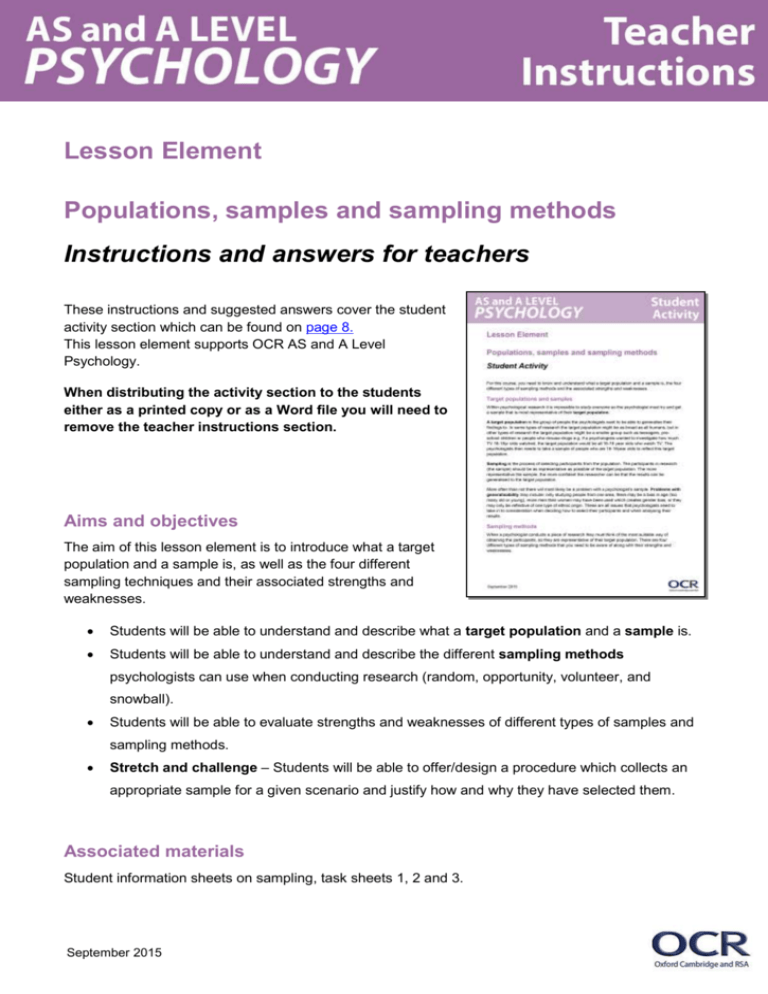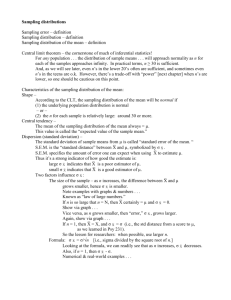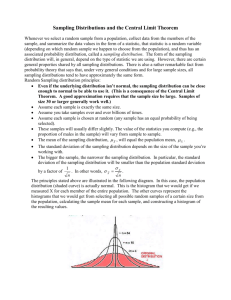Populations, samples and sampling methods
advertisement

Lesson Element Populations, samples and sampling methods Instructions and answers for teachers These instructions and suggested answers cover the student activity section which can be found on page 8. This lesson element supports OCR AS and A Level Psychology. When distributing the activity section to the students either as a printed copy or as a Word file you will need to remove the teacher instructions section. Aims and objectives The aim of this lesson element is to introduce what a target population and a sample is, as well as the four different sampling techniques and their associated strengths and weaknesses. Students will be able to understand and describe what a target population and a sample is. Students will be able to understand and describe the different sampling methods psychologists can use when conducting research (random, opportunity, volunteer, and snowball). Students will be able to evaluate strengths and weaknesses of different types of samples and sampling methods. Stretch and challenge – Students will be able to offer/design a procedure which collects an appropriate sample for a given scenario and justify how and why they have selected them. Associated materials Student information sheets on sampling, task sheets 1, 2 and 3. September 2015 Summary, background and common student misconceptions The AS and A Level specifications state that students need to be familiar with the key features of planning and conducting research. Samples and sampling methods are one of many key factors that need to be considered before psychological research can take place. A sample is the group of people who take part in the investigation. The people who take part are referred to as “participants”. It is important that participants are reflective of the target population and psychologists have a variety of different sampling methods they can choose from in order to obtain a sample for their research. This lesson element is intended to introduce students to what a target population and a sample is. The four different sampling methods outlined in the specification and their associated strengths and weaknesses are also covered. This lesson would be best sequenced very early on in the course as samples and sampling methods are a central part of research considerations. Subsequent lessons on the core studies can then build on students’ knowledge by getting them to evaluate the samples and sampling methods of the core studies as they are learnt. This lesson element should take between one or two hours to complete, but you may want to set tasks before and after the lesson if you are short on time. The main misconception students struggle to grasp with samples, is understanding the difference between the different sampling methods. Also students tend to evaluate the samples on superficial ideas such as the size (being big or small). It is better to stay away from these evaluative points where possible and try and think of the wider picture such as the sample not being representative of whom the target audience is aimed at due to having only one type of person such as students. Task instructions and teacher preparation The tasks can be delivered in a number of ways depending on your teaching style and the types of student you have in your class. All tasks could take place in the classroom, alternatively reading the first page and completing Task 1 could be set as homework to be discussed in the lesson as an introductory activity. Or, teachers may decide to read and explain the written information sheet first, and then work through the tasks (some of which can then be set for homework). The tasks could be set as an individual task or completed as paired or small group work, this again may depend on your preference and students. Selecting students to then read out their answers and summarising them on the board is a good way to maintain focus and ensure that all students have the correct information at the end of the lesson and this is also a good point to explain any misunderstanding. There is a student information sheet that outlines definitions of a target population, samples and sampling methods. Depending on time and circumstances, you could provide students with the associated strengths and weaknesses and miss out task 1. Teachers should print the student handout and provide each student with a copy, as this will be a very useful resource for the future. Each student should also receive the student task sheets unless the activity is planned to be done as a group. The student task sheets are the focus of the lessons and will enable students to consolidate what they have learnt. September 2015 Task 1 – Strengths and weaknesses of sampling methods. Once students have either read about or taught about the four different sampling techniques, the next activity would be to think about strengths and weaknesses of them. This could be done individually (as a homework) or in small groups, it is recommended that students write down their initial ideas in note form before completing the table. Students should be encouraged to consider representativeness, bias, time needed, cost and ease for each sampling method. Directed questioning could be used to get ideas from each group/individual and these thoughts can be used to fill out the strengths and limitations table as a group. Task 2 – Checking your understanding of samples and sampling methods. Students should read the five scenarios and firstly identify which sampling method has been used for the investigation and secondly evaluate the scenarios in terms of strengths and weaknesses of the samples. As an extension task students could evaluate each scenario in terms of its sampling method. Task 3 – Sampling knowledge test. This can be used in a number of different ways depending on your preference. It could be used as a mini assessment to see how much students have learnt at the end of the lesson element. Equally it could be set as a group challenge to see who finishes first, set as a homework activity or used as a starter in the next lesson. Either way students should be encouraged to answer the task without using class notes and rely on what they have learnt. Task 1 – Strengths and weaknesses of sampling methods Students consider the strengths and weaknesses of each sampling method below: Strengths of using an opportunity sample Is the easiest, quickest and most economical way to obtain participants, as the psychologists will use people that they have easy access to. Strengths of using a self-selected sample Gives a wide range of access to potential participants. It is also convenient and ethical if it leads to informed consent Strengths of using a random sample Weaknesses of using an opportunity sample Likely to produce a biased sample as only certain types of people will be selected from limited geographical areas, therefore it is not very representative. Weaknesses of using a self-selected sample Often unrepresentative as it leads to a biased sample, people tend not to respond to adverts, unless they have a strong interest/view to share or a motivation to take part therefore are more likely to respond with demand characteristics. Weaknesses of using a random sample This is the least biased method of sampling, It is very difficult and time consuming to do, as all members of the target population have especially with large target populations. A an equal chance of being selected. representative sample is also not guaranteed. September 2015 Strengths of using a snowball sample Weaknesses of using a snowball sample Possible to include members of groups where no lists or identifiable clusters even exist (e.g., drug abusers, criminals) and who may not be easy to access. There is no way of knowing whether the sample is representative of the population. Task 2 – Checking your understanding of samples and sampling methods Look at the scenarios below. First, identify which sampling method you think has been used and then outline any strengths or weaknesses you can see with the samples. 1) A researcher wanted a selection of gym members to take part in research to see how many hours on average people attended the gym per week. The gym manager put all the names of the gym members from 3 Fitness First gyms in Liverpool in to a hat and picked out 20 to take part in their investigation. Random. Only used gym members from Fitness First so may not be representative of other people who use other gyms, also only used gyms in Liverpool so can only generalise findings to this area of the country. 2) A researcher wanted to find out why people use public transport rather than cars. So he stood at a local train station in Sheffield and asked the first 50 people who were waiting to catch the train to answer his questions. Opportunity. Only used people catching the train so didn’t ask people who used other methods of public transport, also only used people from Sheffield so can’t generalise findings about public transport use to people. The time of day he was there would also attract a certain type of person. September 2015 3) An English teacher is undertaking research in to how well students remember poems whilst listening to music compared to not listening to music. She advertises for participants on the student notice board and leaves an email address for students to respond to. She used the first 50 students who replied to take part in her experiment which consisted of 37 females and 13 males. Self-selected. The sample is gender biased; there are 37 females and only 13 males, therefore generalisation of results may not be appropriate. 4) A researcher wants to investigate lunch time eating habits (do people eat sandwiches or prefer hot food, how often do they eat out etc). He walks in to 3 different restaurants in Manchester; Zizzi, Bella Italia and Wagamama between 12pm – 1pm to find participants to ask about their eating habits. Opportunity. Only used people from Manchester so biased to that area, also only went in to three restaurants which may not be the places that most people would eat at for their lunch, as they wouldn’t have time to sit down and order the food. 5) A psychologist wants to find out how often homeless people make use of sheltered accommodation in the winter months, compared to the summer months. He approaches two homeless men in Bristol city centre and asks them his questions then he asks them to suggest other homeless people who may be willing to take part in his investigation and where he can find them. Snowball. Only used homeless people in Bristol city centre and didn’t study homeless people from any other areas. September 2015 Task 3 – Sampling knowledge test 1. What is the definition of a target population? The group of people the psychologists wants to be able to generalise their findings to. 2. Why is it desirable to obtain a representative sample for a research study? So a psychologist can generalise their findings beyond that sample to the target population. 3. The four different sampling techniques that psychologists can use are: Opportunity Random Self-Selected Snowball 4. How would you obtain a snowball sample? By asking a participant to suggest someone is a member of the target population if they might be willing to take part, or be appropriate for the study. 5. Which would give a researcher a random sample of 20 participants? Tick one and explain why. A. choosing every 3rd person from a list of 60 names listed in order of age B. sticking a pin 20 times into a piece of paper listing 50 names in alphabetical order C. taking out 20 names from a container of 100 names D. using the first 20 people that enter a building 6. Why do very few studies use random sampling as a method of obtaining participants? It is very difficult and time consuming to do, especially with large target populations. 7. What is self-selected sampling? Making use of the people that are readily available to you and willing to participate. 8. What is a weakness of using self-selected sampling? September 2015 It is unrepresentative as it leads to a biased sample, such as people who have a strong interest/view to share or a motivation to take part. 9. Which will give the most representative sample of British teenagers in an investigation into the use of the internet? Tick one and explain why. A. a sample drawn from five GCSE Computer Science classes in a secondary school a sample drawn from ten sixth form colleges across the United Kingdom B. a sample drawn from three secondary schools from different parts of the United Kingdom C. a sample drawn from users of an online gaming website based in the United Kingdom 10. A psychology student who lives in Cornwall is carrying out a project on beliefs about mental health; she asks 20 of her friends, family and neighbours to complete a questionnaire she has prepared. State a problem with the sample in the above scenario: They are all from Cornwall, so views on mental health only apply to that area. Now state a strength and weakness with the sampling method in the above scenario: It is the easiest, quickest and most economical way to obtain participants, as the psychology student simply has to ask her friends, family and neighbours to fill in the questionnaire. It is likely to produce a biased sample as only certain types of people will be selected from limited areas e.g. Cornwall therefore it is not very representative. We’d like to know your view on the resources we produce. By clicking on ‘Like’ or ‘Dislike’ you can help us to ensure that our resources work for you. When the email template pops up please add additional comments if you wish and then just click ‘Send’. Thank you. If you do not currently offer this OCR qualification but would like to do so, please complete the Expression of Interest Form which can be found here: www.ocr.org.uk/expression-of-interest OCR Resources: the small print OCR’s resources are provided to support the teaching of OCR specifications, but in no way constitute an endorsed teaching method that is required by the Board, and the decision to use them lies with the individual teacher. Whilst every effort is made to ensure the accuracy of the content, OCR cannot be held responsible for any errors or omissions within these resources. © OCR 2015 - This resource may be freely copied and distributed, as long as the OCR logo and this message remain intact and OCR is acknowledged as the originator of this work. OCR acknowledges the use of the following content: Maths and English icons: Air0ne/Shutterstock.com Please get in touch if you want to discuss the accessibility of resources we offer to support delivery of our qualifications: resources.feedback@ocr.org.uk September 2015 Lesson Element Populations, samples and sampling methods Student Activity For this course, you need to know and understand what a target population and a sample is, the four different types of sampling methods and the associated strengths and weaknesses. Target populations and samples Within psychological research it is impossible to study everyone so the psychologist must try and get a sample that is most representative of their target population. A target population is the group of people the psychologists want to be able to generalise their findings to. In some types of research the target population might be as broad as all humans, but in other types of research the target population might be a smaller group such as teenagers, preschool children or people who misuse drugs e.g. if a psychologists wanted to investigate how much TV 16-18yr olds watched, the target population would be all 16-18 year olds who watch TV. The psychologists then needs to take a sample of people who are 16-18year olds to reflect this target population. Sampling is the process of selecting participants from the population. The participants in research (the sample) should be as representative as possible of the target population. The more representative the sample, the more confident the researcher can be that the results can be generalised to the target population. More often than not there will most likely be a problem with a psychologist’s sample. Problems with generalisability may include: only studying people from one area, there may be a bias in age (too many old or young), more men than women may have been used which creates gender bias, or they may only be reflective of one type of ethnic origin. These are all issues that psychologists need to take in to consideration when deciding how to select their participants and when analysing their results. Sampling methods When a psychologist conducts a piece of research they must think of the most suitable way of obtaining the participants, so they are representative of their target population. There are four different types of sampling methods that you need to be aware of along with their strengths and weaknesses. September 2015 Task 1 – Read about each sampling method and consider possible strengths and weaknesses Opportunity Sampling: This is the easiest, most common and cheapest method of sampling. It is simply about making use of the people that are readily available to you and willing to participate. For example, if a psychologist wanted to study how much TV 16-18 year olds watched. In order to use an opportunity sample they may simply go in to the nearest sixth form college and ask permission from the Principal to ask students about how much TV they watch as they enter the college. Strengths of using an opportunity sample Weaknesses of using an opportunity sample Self-Selected (Volunteer) Sample: People who want to take part in research volunteer themselves. The psychologist will place an advert (this could be a poster, a flyer distribution, a TV advert, mail out, etc) then people interested in the study would reply to the advert and the psychologist would filter the responses to collect a sample that reflected his target population. They would then be contact them to take part. E.g. put a poster up in colleges around the UK for 16-18 year olds to take part in a study about how much TV they watch and filter the responses to gain 50 16-18 year olds to study. Strengths of using a volunteer sample Weaknesses of using a volunteer sample Random sampling: Every member of the target population has an equal chance of being selected. The researcher needs the names of all members of their target population. All potential participants are entered into a draw of some kind and names are randomly selected until the desired number of participants is chosen. Participants are then contacted to take part. For example, if I wanted to look at 16-18 year olds use of TV from a college in the northwest, I would access the student data base of the college with all student names on and use a random number generator to select a sample of students and then contact them to take part. Strengths of using a random sample September 2015 Weaknesses of using a random sample Snowball sampling: Snowball sampling can be used if your population is not easy to contact. A snowball sample is achieved by asking a participant to suggest someone else who might be willing or appropriate for the study. Snowball samples are particularly useful in hard to obtain populations, such as truants, drug users, etc. Strengths of using a snowball sample Weaknesses of using a snowball sample Task 2 – Checking your understanding of samples and sampling methods Look at the scenarios below, firstly identify which sampling method you think has been used and then outline any strengths or weaknesses you can see with the samples. 1. A researcher wanted a selection of gym members to take part to see how many hours on average people attended the gym per week. The gym manager put all the names of the gym members from 3 Fitness First gyms in Liverpool in to a hat and picked out 20 to take part in their investigation. 2. A researcher wanted to find out why people use public transport rather than cars. So he stood at a local train station in Sheffield and asked the first 50 people who were waiting to catch the train to answer his questions. September 2015 3. An English teacher is undertaking research in to how well students remember poems whilst listening to music compared to not listening to music. She advertises for participants on the student notice board and leaves an email address for students to respond to. She used the first 50 students who replied to take part in her experiment which consisted of 37 females and 13 males. 4. A researcher wants to investigate lunch time eating habits (do people eat sandwiches or prefer hot food, how often do they eat out etc). He walks in to 3 different restaurants in Manchester; Zizzi, Bella Italia and Wagamama between 12pm – 1pm to find participants to ask about their eating habits. 5. A psychologist wants to find out how often homeless people make use of sheltered accommodation in the winter months, compared to the summer months. He approaches two homeless men in Bristol city centre and asks them his questions then he asks them to suggest other homeless people who may be willing to take part in his investigation and where he can find them. September 2015 Task 3 – Sampling knowledge test 1. What is the definition of a target population? 2. Why is it desirable to obtain a representative sample for a research study? 3. The four different sampling techniques psychologists can use are: 4. How would you obtain a snowball sample? 5. Which would give a researcher a random sample of 20 participants? Tick one and explain why. A. Choosing every 3rd person from a list of 60 names listed in order of age. B. Sticking a pin 20 times into a piece of paper listing 50 names in alphabetical order. C. Taking out 20 names from a container of 100 names. D. Using the first 20 people that enter a building. September 2015 6. Why do very few studies use random sampling as a method of obtaining participants? 7. What is self-selected sampling? 8. What is a weakness of using volunteer sampling? 9. Which will give the most representative sample of British teenagers in an investigation into the use of the internet? Tick one and explain why. A. A sample drawn from five GCSE Computer Science classes in a secondary school. B. A sample drawn from ten sixth form colleges across the United Kingdom. C. A sample drawn from three secondary schools from different parts of the United Kingdom. D. A sample drawn from users of an online gaming website based in the United Kingdom. September 2015 10. A psychology student who lives in Cornwall is carrying out a project on beliefs about mental health; she asks 20 of her friends, family and neighbours to complete a questionnaire she has prepared. State a problem with the sample in the above scenario: Now state a strength and weakness with the sampling method in the above scenario: September 2015








